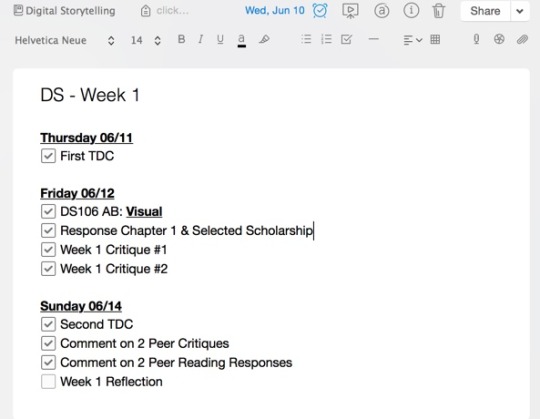The Daily Create- Bride Throwing Cat


As week one slowly comes to a close I tell myself “only seven more weeks!”. Don’t get me wrong, I think this will be a great semester. Challenging, yes, but a definitely a learning opportunity.
If I were to use one word to summarize how I feel about this week: overwhelmed. After careful review of the course syllabus and Canvas pages, I identified at least 9 assignments due each week, not including the required reading. In an attempt to stay organized I created notes within Evernote to track when assignments were due each week, checking off those that have been completed (see image below). But please don’t think I’m simply completing assignments for the sake of completing them. If I felt that the workload was too much and could not provide quality assessments and critiques I would most likely drop this class.

I found most of the assignments fun and rewarding - especially the TDC’s and Visual AB. Although the critiques were not as fun, I am learning a lot from peer reviews as well as what I would/would not do for my own storytelling projects. I have used Twitter and Tumblr more in the past 5 days than I thought I ever word. Much thanks to Remi for providing other resources to track social media posts (Tweetdeck & Feedly).
It may be a little too early to have a favorite assignment. However the TDC assignments are engaging and fun. I get to see the creative side of my peers and leverage some of the ideas and design decisions for future projects.
At this point I can’t say I would do anything differently. I understand this is a summer class and naturally the pace and workload would be greater than if this were a traditional semester in length. I just didn’t imagine it would be like this.
As for my focal theme, I am struggling to find digital storytelling resources/samples to support my “change management”. Several assignments ask us to incorporate scholastic resources of our focal theme into our critique. This has been a challenge for me, prompting me to reconsider my theme.
Lastly, on a scale from 1-10 I think my participation in the class and completion of the assignments thus far is on par for a 10. The rubric clearly states that grads should not be awarded based on “effort”, but I hope there is at least an appreciation of all of the effort being made to complete these assignments in such a small amount of time - especially considering other obligations outside school (full-time work, family, etc).
The hype machine is my constant enemy. I love getting recommendations for books, tv, movies, podcasts, but I also fear the inevitable tipping point where my goodnatured nods and affirmation become more bitter and cynical. “Serial? No I haven’t listened to it. Mmhmm, I hear it’s good. Yep, I know I have to listen to it. Yes, I do believe it will blow my mind.”
“Satisfaction (b1) must be equal and opposite to the effect of expectations (- b1)” - from Handbook of Research on Contemporary Theoretical Models in Information Systems edited by Dwivedi, Yogesh K. It’s entirely unnecessary to pull that quote from such a weighty text, but the toothpaste is out of the tube here. The higher the level of expectation the lower the satisfaction, and vice-versa. This is my roundabout way of saying that I entered the Serial podcast with clenched teeth: “Ok, here we go. Time to hear what everyone is talking about.” And it was…good. Really good. The pacing was mostly effective and thoughtful. The earnestness of Koenig was particularly refreshing - some of my favorite moments where when she wrestled with her inner doubts right along with her listeners: Did he do it?
Serial is arguably the most recent example of a new era of “digital storytelling,” which is funny since it is fundamentally based on a pre-digital technology (radio). In reality, it has a lot working against it - an old story (15 years in the past), and a thin cast of characters (not many people are interviewed). But what it does have is Koenig’s compulsion to figure out what happened - not only for the truth of the story, but also to be set free herself. Koenig’s narration is closer to Poe’s narrator in the “Tell-Tale Heart” than it is to a confident, careful investigator (say…Matlock). Her own sense of truth and justice and the integrity of her moral compass quickly become caught up in the puzzle and I found that most compelling of all.
“With respect to literacy and economic growth and well-being, it was increasingly believed that the average literacy level of a country’s population is a better indicator of economic growth than is educational achievement as measured by credentials.”
Startling stuff for developed nations that are busy using other metrics to determine economic growth: job creation, trade deficit, inflation, etc. As Freier identified, literacy is closer to critical thinking than it is to alphabetic decoding. So if it’s so important than we must need to legitimize it in quantifiable ways (particularly with data).
“New Literacies
As an institutionalized activity of the state, education is seen to be
legitimated through the principle of performativity (Lyotard 1984). This is
the principle of optimizing the overall performance of social institutions (like
schools) according to the criterion of efficiency: the ‘endless optimization of
the cost/benefit (input/output) ratio’ (Lyotard 1993: 25).
“
It’s a slippery slope. I think that Knobel and Lankshear are saying what many teachers would echo. Data is a priority, yes, but if we don’t look at the validity of the data, the quality of the data, then we are building our next steps off faulty premises. I really like the concept of “performativity” that something can only be legitimate if it can demonstrate performance.
Attention has to be given to what this chapter is primarily discussing: “new” literacies. Though Knobel and Lankshear are careful to delineate between “new” and “digital” I think the point is clear, that there the contemporary avenues of literacy (or thinking if we can be so broad) involve but are not limited to digital competencies, the importance of which are equal to Freir’s work (though the technologies and “forums” may have changed). I don’t know how comfortable I am with “new” literacy. The first half of the chapter spends time discussing why the “old” literacy model has largely failed, or at the least, been called into question.
The chapter ends soon after this revelation and I’m left wondering what this means for literacy - here’s the only analogy I can think of: should we use current lingo because it is current, or should we use it because it creates something fresh, and new, and intentional that wasn’t there before. Do we really need to acknowledge Yuh-Gi-Oh as a means of more deeply understanding the critical processes that undergird literacy? Or is our time better spent drawing more inclusive lines around what has been deemed to be the English “canon.” I am in favor of the latter, but for every argument about “dead white guy” bias, we oversimplify the argument to author instead of theme. Ideas have no race, or class, or educational status.



This flower is for @Peachey_Pie who brought me into the twitter fold for Digital Storytelling. May this crazy Dr. Seuss-ian flower bring you joy and happiness and may your enemies tremble before you.